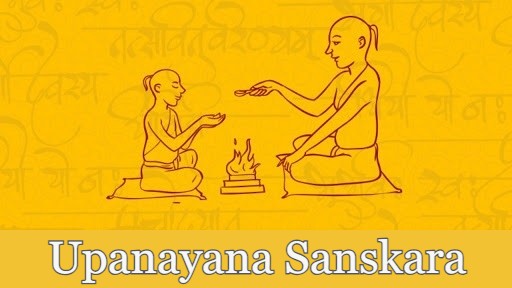Significance of Upanayana Sanskar and Auspicious Dates to Perform in 2024

Upanayana, or Janeu Samskara or sacred thread ceremony, is one of the 16 samskaras followed by Sanatan Hindus since ancient times. It is the 10th samskar mentioned in the ancient Sanatan Hindu Dharma that should be followed right from conception until death. In this ceremony, the boy has to wear a sacred white thread (Janeu) in a proper ritualistic manner. Earlier, in ancient India, the ritual was followed by people just before Vedarambha. It was considered essential for performing yagnas or sacred rituals. It means when the children reached the age of starting their Veda Gyan, they were sent to Gurukuls after the Upanayana ceremony. Today, the ceremony is observed mainly by Brahmins, Kshatriyas, Baniyas and a few more, depending on their beliefs.
Upanayanam is a shortened form of Yagnopaveetam, a Sanskrit term referring to a sacred covering worn on the body. Yagnopaveetham is also called Brahmasutram or Brahmopadesa. In Telugu, it is called Jandhyam, in Tamil, it is called Poonal; and in Kannada, it is called Janivara. In many other parts of the country, it is also known as Janeu or Upanayana.
The Sanskrit word ‘Upanayana’ comprises two words; ‘Up” and ‘Nayana”. ‘Up’ means near and ‘Nayan’ means eyes or vision. It literally means keeping ourselves away from darkness (a state of ignorance) and getting towards the light (spiritual knowledge).
Here, you can find the 2024 Upnayan Sanskar Shubh Samay and date plans.
January 2024, Upanayana Sanskar Shubh Samay:
| Date | Days | Timing |
| 21 Jan 2024 | Sunday | 19:30 – 23:50 |
| 31 Jan 2024 | Wednesday | 07:10 – 11:30 |
February 2024, Upanayana Sanskar Shubh Samay:
| Date | Days | Timing |
| 12 Feb 2024 | Monday | 07:10 – 14:50 |
| 14 Feb 2024 | Wednesday | 11:35 – 12:00 |
| 19 Feb 2024 | Monday | 07:00 – 21:00 |
| 29 Feb 2024 | Thursday | 06:50 – 10:10 |
March 2024, Upanayana Sanskar Shubh Samay:
| Date | Days | Timing |
| 27 Mar 2024 | Wednesday | 09:40 – 16:00 |
| 29 Mar 2024 | Friday | 20:40 – 23:30 |
April 2024, Upanayana Sanskar Shubh Samay:
| Date | Days | Timing |
| 12 April 2024 | Friday | 13:15 – 23:30 |
| 17 April 2024 | Wednesday | 15:15 – 23:30 |
| 18 April 2024 | Thursday | 06:00 – 07:00 |
May 2024, Upanayana Sanskar Shubh Samay:
| Date | Days | Timing |
| 9 May 2024 | Thursday | 13:00 – 17:00 |
| 10 May 2024 | Friday | 10:40 – 17:00 |
| 12 May 2024 | Sunday | 12:50 – 19:30 |
| 17 May 2024 | Friday | 10:10 – 14:40 |
| 18 May 2024 | Saturday | 10:15 – 16:50 |
| 19 May 2024 | Sunday | 14:40 – 16:55 |
| 20 May 2024 | Monday | 10:00 – 16:40 |
| 24 May 2024 | Friday | 07:30 – 11:50 |
| 25 May 2024 | Saturday | 12:00 – 14:00 |
June 2024, Upanayana Sanskar Shubh Samay:
| Date | Days | Timing |
| 8 June 2024 | Saturday | 11:00 – 17:50 |
| 9 June 2024 | Sunday | 11:00 – 17:40 |
| 10 June 2024 | Monday | 17:50 – 20:00 |
| 16 June 2024 | Sunday | 08:10 – 14:50 |
| 17 June 2024 | Monday | 10:30 – 17:00 |
| 22 June 2024 | Saturday | 07:50 – 12:20 |
| 23 June 2024 | Sunday | 07:40 – 12:10 |
| 26 June 2024 | Wednesday | 09:50 – 16:40 |
July 2024, Upanayana Sanskar Shubh Samay:
| Date | Days | Timing |
| 7 July 2024 | Sunday | 11:30 – 18:00 |
| 8 July 2024 | Monday | 11:25 – 18:00 |
| 10 July 2024 | Wednesday | 13:30 – 18:00 |
| 11 July 2024 | Thursday | 06:30 – 11:00 |
| 17 July 2024 | Wednesday | 07:40 – 08:20 |
| 22 July 2024 | Monday | 06:10 – 12:30 |
| 25 July 2024 | Thursday | 08:05 – 17:00 |
August 2024, Upanayana Sanskar Shubh Samay:
| Date | Days | Timing |
| 7 August 2024 | Wednesday | 11:40 – 18:00 |
| 9 August 2024 | Friday | 07:00 – 11:20 |
| 14 August 2024 | Wednesday | 11:10 – 13:20 |
| 15 August 2024 | Thursday | 13:30 – 17:40 |
| 16 August 2024 | Friday | 11:15 – 17:40 |
| 17 August 2024 | Saturday | 06:30 – 08:30 |
| 21 August 2024 | Wednesday | 07:30 – 12:30 |
| 23 August 2024 | Friday | 13:00 – 15:00 |
| 24 August 2024 | Saturday | 06:45 – 08:00 |
September 2024, Upanayana Sanskar Shubh Samay:
| Date | Days | Timing |
| 4 September 2024 | Wednesday | 12:10 – 18:00 |
| 5 September 2024 | Thursday | 12:15 – 18:00 |
| 6 September 2024 | Friday | 12:00 – 16:00 |
| 8 September 2024 | Sunday | 14:15 – 16:00 |
| 13 September 2024 | Friday | 09:15 – 15:50 |
| 14 September 2024 | Saturday | 07:25 – 09:00 |
| 15 September 2024 | Sunday | 11:30 – 17:25 |
October 2024, Upanayana Sanskar Shubh Samay:
| Date | Days | Timing |
| 4 October 2024 | Friday | 12:30 – 17:30 |
| 7 October 2024 | Monday | 14:30 – 18:00 |
| 12 October 2024 | Saturday | 12:00 – 15:30 |
| 13 October 2024 | Sunday | 09:40 – 15:30 |
| 14 October 2024 | Monday | 07:15 – 09:00 |
| 18 October 2024 | Friday | 07:10 – 13:30 |
| 21 October 2024 | Monday | 09:15 – 15:00 |
November 2024, Upanayana Sanskar Shubh Samay:
| Date | Days | Timing |
| 3 November 2024 | Sunday | 07:15 – 10:20 |
| 4 November 2024 | Monday | 07:15 – 10:20 |
| 6 November 2024 | Wednesday | 07:15 – 12:00 |
| 11 November 2024 | Monday | 10:00 – 15:00 |
| 13 November 2024 | Wednesday | 07:40 – 09:40 |
| 17 November 2024 | Sunday | 07:25 – 13:00 |
| 20 November 2024 | Wednesday | 11:30 – 15:50 |
December 2024, Upanayana Sanskar Shubh Samay:
| Date | Days | Timing |
| 4 December 2024 | Wednesday | 07:40 – 10:25 |
| 5 December 2024 | Thursday | 13:40 – 18:30 |
| 6 December 2024 | Friday | 07:45 – 12:00 |
| 11 December 2024 | Wednesday | 10:15 – 16:00 |
| 12 December 2024 | Thursday | 07:45 – 09:50 |
| 16 December 2024 | Monday | 07:40 – 12:50 |
| 19 December 2024 | Thursday | 11:15 – 14:00 |
Now that you know the auspicious times for Upanayan Sanskar, you must also learn here why Upanayana or sacred thread, is significant and how the rituals are performed.
Janeu Ceremony Importance
All 16 sanskaras are very essential in Sanatan Hindu culture and each one holds a special significance. Upanayana, Janeu Sanskara or Yagnopaveetam is very significant among Hindus who follow the custom. With the Janeu ceremony, a boy grows from a child to a teenager. However, the ceremony can be performed when the boy is between the ages of 8 and 16. In ancient Bharat, this was the age when they were sent to Gurukul for Vedarambha, which commenced just after Upanayana. To establish this, the priest ties a sacred thread (Janeu) above the boy’s left shoulder and under the right arm.
The Janeu is an interwoven strand of three threads. Here, we will learn more about Janeu or the sacred thread.
Length of Janeu
The length of Yagnopavit is 96 fingers. It calls for the person wearing Janeu to try and learn 64 arts and 32 disciplines. 32 Vidyas are four Vedas, four Upvedas, six Darshanas, six Agamas, three Sutras, and nine Aranyakas.
Three Strands of Janeu
The three strands of a Janeu represent the three main Hindu deities: Brahma, Vishnu, and Mahesh. They also signify the three debts a person owes: Devaruna (debt to the gods), Pitruruna (debt to the ancestors), and Rishiruna (debt to the sages). Additionally, some believe that the three strands represent the three Gunas: Sattva, Rajas and Tamas. Furthermore, the Janeu symbolises the three stages of the Gayatri Mantra, a sacred Hindu hymn. Lastly, it represents the three ashrams (stages of life): Brahmacharya (student), Grihastha (householder), and Vanaprastha (retired). In the final stage, the Sannyas Ashram (renunciation) and the Janeu or Yajnopavita (sacred thread) is removed.
Nine Chords of Janeu
Each chord of Janeu has three strings, adding the total number of strings to nine.
The Five Knots
Five knots are placed in Janeu, which represent Brahma, Dharma, Ardha, Kama, and Moksha. It is also a symbol of Panchakarma, Gyandarias, and Yajna, all of them are five in number.
Wearing a Janeu
While wearing the Janeu, the child only holds the stick. The boy on whom the Yagnopavit is performed wears only one unstitched piece of clothing and a yellow fabric around the neck. A yagna (a sacred fire ritual) has to be performed when the Janeu is worn. The child and his family are present during the yajna. The Janeu is worn after “Guru Diksha” (initiation by the Guru). And Janeu has to be changed every time it becomes impure.
Gayatri Mantra
Janeu begins with the Gayatri Mantra, which has three stages. ‘Tatsvituvarnrayan’ is the first stage; ‘Bhargo Devasya Dhimahi’ is the second stage; and ‘Dhio yo na: Prachodayat’ is the third stage.
Mantra While Wearing a Janeu
यज्ञोपवीतं परमं पवित्रं प्रजापतेर्यत्सहजं पुरस्तात् ।
आयुष्यमग्रं प्रतिमुञ्च शुभ्रं यज्ञोपवीतं बलमस्तु तेजः।।
The Upanaya ceremony holds deep significance for Hindus who follow it.
There is much debate on whether ancient Sanatan Hindu women used to wear Janeu. Some scholars say women never wore Janeu while others say they wore it around their neck like a neckless and after marriage, their husbands used to wear it on their behalf. So, their husbands wore one Janeu for themselves and one for their wives. Thus, according to some religious experts, in ancient India, married men wore two janeus. However, in today’s India, Upanayan is performed only on boys and not girls. The reason could be physical attributes that may become a hindrance to the correct observance of the ritual. Also, in the mediaeval period, due to outside attacks, girls were restricted within their houses, and hence this ritual may have come to an end. But if the Upanayana ritual was performed on girls, there is no documented evidence to prove why or how it came to an end.









